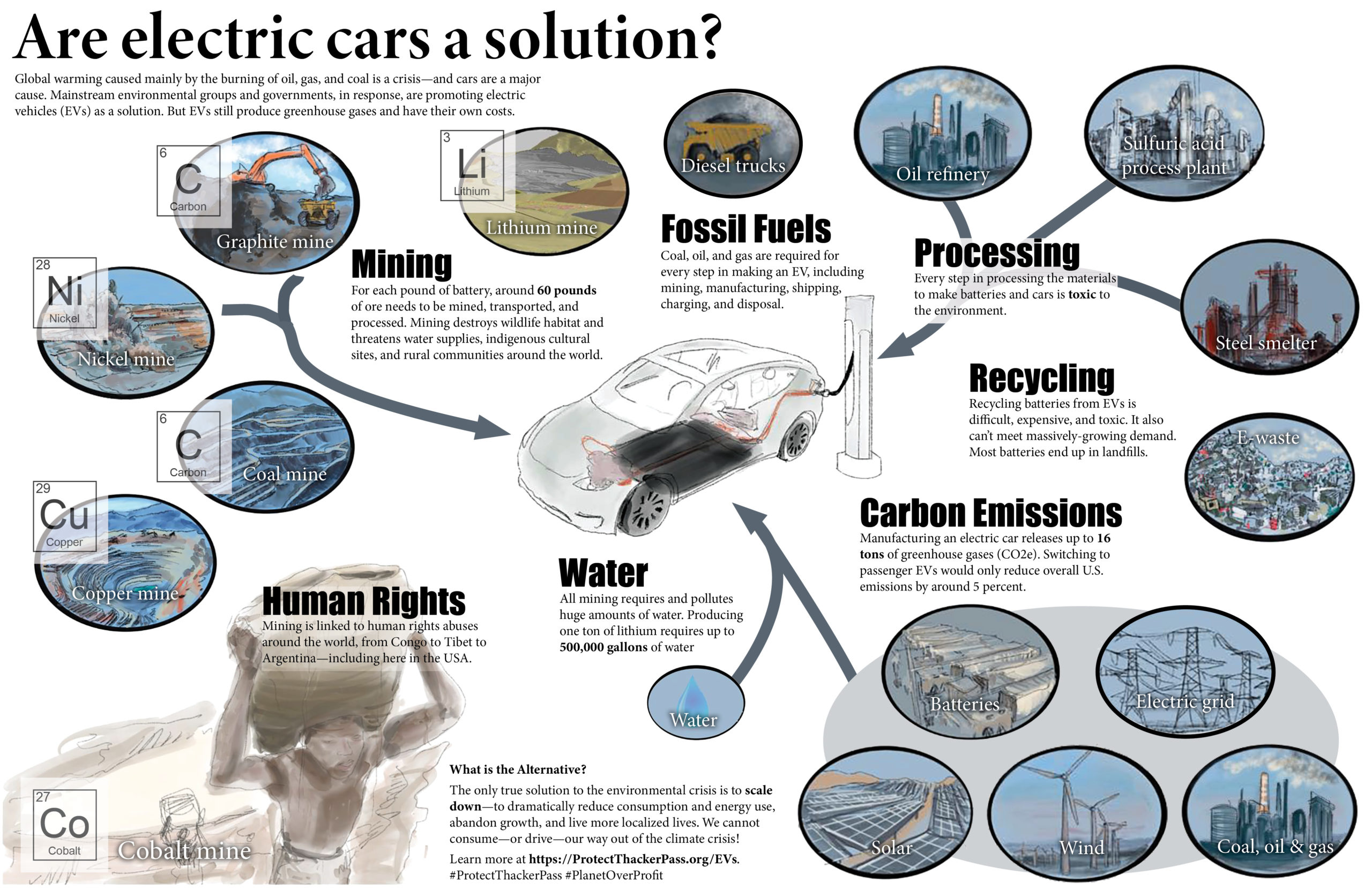Are Electric Cars a Solution?

Citations
Each pound of battery requires processing 60 pounds of ore: “Through the Eye of a Needle: An Eco-Heterodox Perspective on the Renewable Energy Transition”, by Megan Seibert and William Rees, published in MDPI on July 26, 2021. “For every kilogram of battery, 50–100 kg of ore needs to be mined, transported, and processed.”
Human rights abuses in Argentina: “Lithium extraction in Argentina: a case study on the social and environmental impacts“, FARN, Argentina
Human rights abuses in Congo: “Toxic Cost of Going Green” by Unreported World for the BBC; “Blood Cobalt” (also on YouTube) by Michael Davie for Australian Broadcasting Company (ABC) News In-depth.
Human rights abuses in Tibet: “Tibetans in anguish as Chinese mines pollute their sacred grasslands“, by Simon Denyer for Washington Post, December 26, 2016
Human rights abuses in USA:
Abandoned Mine Lands: Site Information – a list of abandoned hardrock mines and mineral processing sites listed in the EPA’s Superfund system.
https://www.mining.com/most-miners-lag-behind-in-human-rights-issues-report/ – overall human rights abuses in mining sector
Exposure to toxic substances in US mining sector: Mining Topic: Exposure Monitoring to Dust and Toxic Substances, by US Centers for Disease Control and Prevention. “The workers employed in U.S. mining facilities are exposed to elevated levels of toxic aerosols including respirable dust, diesel particulate matter (DPM), and crystalline silica. Exposure to airborne aerosols can lead over time to debilitating respiratory diseases that can affect the health of workers.”
The Lasting Harms of Toxic Exposure in Native American Communities, by Sanjana Manjeshwar for Berkeley Political Review, July 10, 2021
Mining and Environmental Health Disparities in Native American Communities, by Lewis et. al for Current Environmental Health Reports, 2017.
Each ton of lithium requires up to 500,000 gallons of water: “The spiralling environmental cost of our lithium battery addiction“, by Amit Katwala for Wired Magazine, May 8, 2018
Manufacturing an EV releases up to 16 tons of CO2: “Cradle-to-gate greenhouse gas emissions of battery electric and internal combustion engine vehicles in China” by Qiao Q et. al. for Applied Energy, 2017.
Recycling is toxic: A Dead Battery Dilemma by Ian Morse for Science, May 20, 2021.
Recycling can’t meet demand: Vehicle Technologies Office’s Research Plan to Reduce, Recycle, and Recover Critical Materials in Lithium-Ion Batteries, by the U.S. Department of Energy (DoE) Office of Energy Efficiency and Renewable Energy, June 2019. “Currently, lithium-ion batteries are only collected and recycled at a rate of less than 5%. Recycled material could potentially provide one-third of the United States cathode material needs for lithium-ion batteries by 2030”
The Race to Crack Battery Recycling–Before It’s Too Late, by Daniel Oberhaus for Wired Magazine, Nov 30, 2020 – it costs more to recycle lithium batteries than to mine more lithium.
Most batteries end up in landfills: “Through the Eye of a Needle: An Eco-Heterodox Perspective on the Renewable Energy Transition”, by Megan Seibert and William Rees, published in MDPI on July 26, 2021. “Only 5% of all lithium batteries are recycled.”
Every step in processing and manufacturing batteries is toxic:
Step 1: Mine the materials required to build a lithium-ion battery. These materials include lithium, copper, nickel, cobalt, graphite, aluminum, and manganese. All these materials must be mined, and all mining creates toxic waste. In the US alone, 50 million gallons of contaminated wastewater streams daily from mine sites into waterways, waste that includes arsenic, lead, and heavy metals. According to the EPA metals mining causes almost 50% of the toxic waste that enters the environment every year.
Step 2: Refine the materials required to build a lithium-ion battery. Environmental Costs of Refineries, for Mission 2016: Strategic Mineral Management, Massachusetts Institute of Technology (MIT).
A specific example – copper refining: Copper Mining and Production Wastes, US EPA.
A specific example – nickel refining: ‘A Trash Heap for Our Children’: How Norilsk, in the Russian Arctic, Became One of the Most Polluted Places on Earth, by Marianne Lavelle, for Inside Climate News, November 28, 2021.
A specific example – cobalt refining: Life cycle assessment of cobalt extraction process, by Farjana et. al. for Journal of Sustainable Mining, August 2019.
A specific example – graphite refining:
Impervious Graphite Manufacturing Process by GAB Neumann, a company that makes graphite processing equipment.
Humber Refinery gigafactory: Britain’s best-kept industrial secret is an unexpected solution to saving the planet, by Ed Conway for Sky News, Feb 14, 2022.
Step 3: Manufacture battery parts. Parts of batteries are made all around the world. For example, electcrodes for EV batteries are primarily made in China, and the battery cells are primarily made in South Korea. All the technologies to create the parts of batteries are complex and highly technical requiring specialized machinery and electronics. To create electrodes for Lithium-ion batteries:
“Typically, four main steps are involved for electrode processing of commercial LIBs, including slurry mixing, coating, electrode drying, and calendering. Firstly, the dry electrode components (active materials, conductive agents, and binders) are mixed with solvents to obtain a liquid slurry with uniformly distributed particles. Then the obtained liquid slurries are coated on metallic foil current collectors and smoothed to be uniform electrode films. The as-obtained films are subsequently heated to adequately remove solvent out of electrode films. Finally, the film is compressed by two metal rollers to a proper thickness with superior and uniform porosity.” — From Advanced electrode processing lithium-ion batteries: A review of powder technology in battery fabrication by Liu et. al. for Particuology, August 2021.
Step 4: Assemble a lithium-ion battery. To create batteries for EVs, factories must be built where the batteries are made. These factories are high-tech, robotic factories, that require resources (including metals, concrete, steel, and a huge number of computers, semi-conductors, and silicon transistors) to build. These factories are themselves toxic to build. This video gives a sense of the technology and factory used to build Tesla batteries: https://www.youtube.com/watch?v=NTb3SNtwTjg.
The raw materials for batteries come from all over the world, so they must be shipped from refineries to locations where components will be manufactured, and then shipped again to where those components will be assembled into batteries. Shipping is a carbon-intensive, toxic industry. Maritime shipping causes 3% of annual global greenhouse gas emissions, and uses extremely polluting bunker fuel. Heavy trucks (used for shipping) cause 24% of transportation greenhouse gas emissions in the US.
Solutions
One of the most common questions we’re asked is “If electric vehicles aren’t the answer, what is your solution?”
True sustainability is not nearly as simple and easy as buying different products, like electric cars, and putting up solar panels and wind turbines. A truly sustainable life doesn’t mean swapping out gas for lithium-ion batteries.
The state of the planet is dire, from melting ice caps to expanding deserts, from clearcut logging to soil erosion, from the collapse of ocean fish populations to rising temperatures. Our planet is already deep into the 6th mass extinction crisis.
Reversing these trends will mean transforming our entire society, from top to bottom. It will entail changing the foundation of our economy, our communities, our work, our political structures, and beyond. This is daunting, and it is also our only hope.
But this is still vague. What, exactly, does this transformation look like? What is our solution?
Read about our solution here: If Electric Cars Won’t Save the Planet, What Will?
